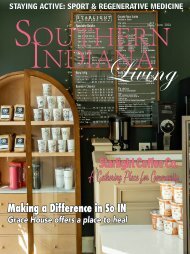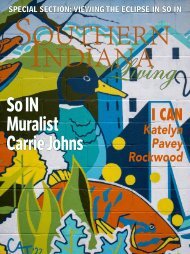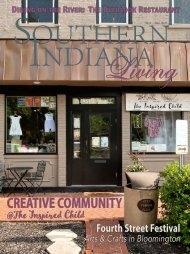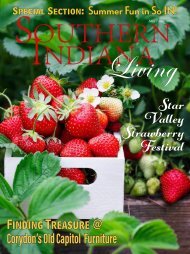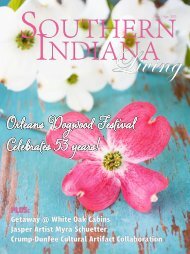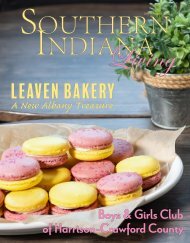Southern Indiana Living - Sept / Oct 2022
Southern Indiana Living Magazine - September / October 2022 Issue
Southern Indiana Living Magazine - September / October 2022 Issue
You also want an ePaper? Increase the reach of your titles
YUMPU automatically turns print PDFs into web optimized ePapers that Google loves.
A Walk in the Garden with Bob Hill<br />
The bright orange crocosmia –<br />
roughly 3,700 miles from its<br />
original home – was hidden<br />
behind a pile of wood chips<br />
in the back field, barely peeking over<br />
the edge as if looking for some salvation,<br />
a helping hand.<br />
Mission accomplished. I feared<br />
I had lost them all, refugees from a<br />
trip to Ireland about 10 years ago,<br />
smuggled home in a plastic bag. Such<br />
thievery is, of course, wrong, illegal<br />
and possibly horticulturally unhealthy.<br />
On the other hand, the crocosmia<br />
were taken from the edges of a<br />
crumbing stone house above the Atlantic<br />
Ocean near Waterford – the<br />
very house in which my Irish family<br />
lived hundreds of years ago before<br />
immigrating to the United States in<br />
the 1880s.<br />
The. Home. Place.<br />
So, I plead guilty to plant thievery,<br />
your honor, but I was very careful<br />
to wash the roots, and minimize any<br />
possible disease damage. What better<br />
living memory to have in our <strong>Indiana</strong><br />
garden than some flowers from my<br />
great-grandma’s Irish garden? And<br />
we left a few billion crocosmia behind<br />
in the homeland, scattered like orange<br />
weeds across the country from<br />
County Cork to County Donegal.<br />
And truth be told those crocosmia<br />
– once labeled montbretia – were<br />
originally native to South Africa,<br />
about 6,000 miles south of Dublin.<br />
They proved to be a perfect match for<br />
the Irish climate, and I was only helping<br />
the going eradication program.<br />
The larger picture being every<br />
garden needs some keepsake plants,<br />
mementoes brought home from foreign<br />
lands, or reminders of friends<br />
both here and gone.<br />
We have many. Our larger<br />
keepsakes include a crab-apple tree<br />
given to us almost 40 years ago by<br />
Janet Hill’s Uncle Elmer, a raggedy<br />
little seedling that has since become<br />
a raggedy old thing, but mostly still<br />
safe from the chain saw. On the other<br />
hand, it’s in way too much shade now<br />
and nostalgia has its limits.<br />
Closer to the house are day lilies<br />
and rain lilies given to us by Elmer’s<br />
wife, the Legendary Aunt Helen, a<br />
quiet, fearsome gardener of whom<br />
it was said could grow tomatoes in<br />
asphalt. We have a now 40-foot and<br />
8 • <strong>Sept</strong>/<strong>Oct</strong> <strong>2022</strong> • <strong>Southern</strong> <strong>Indiana</strong> <strong>Living</strong><br />
Irish Refugees<br />
glorious oak tree given to us as a 10-<br />
foot, balled-and-burlapped gift by a<br />
member of the famed Monarchs band<br />
after I did a story about the group. I<br />
start humming their fabled hit, “Look<br />
Homeward Angel,” when I look at it.<br />
We have another huge oak leaf<br />
tree that, when as a transplanted<br />
seedling, was run over by my father<br />
while backing up his car. The tree reminds<br />
us of that moment every year<br />
by hurling hundreds of acorns down<br />
every fall in retribution.<br />
We have a Kentucky coffee tree<br />
as a gift from a nursery friend, ferns<br />
in the shade and iris in the sunshine,<br />
succulents in the plant room and native<br />
azaleas in the woods, all the latter<br />
gifts with names attached, including<br />
another garden legend, Fred Wiche.<br />
The plant that kicks up the most<br />
seasonal memories for us is the agapanthus,<br />
which we first saw in New<br />
Zealand and happily blooms in the<br />
summers in <strong>Southern</strong> <strong>Indiana</strong>. Agapanthus,<br />
like our crocosmia, is also<br />
native to South Africa, so consider<br />
that mileage to <strong>Indiana</strong>.<br />
New Zealand really stirs up<br />
memories because the trip was just<br />
a spur-of-the-moment idea. We’d<br />
heard and read about it. Great plants<br />
and gardens and it’s warm way down<br />
there when cold up here. Our companions<br />
were two old friends from<br />
Minnesota who really wanted to get<br />
out of the cold.<br />
So, there we were in Christchurch<br />
walking the town’s botanic<br />
garden, headed south along the Pacific<br />
Ocean, west to a boat ride from<br />
Milford Sound, looking south to the<br />
Tasmanian Sea and Antarctica.<br />
The food was wonderful, the<br />
people fun and easy going, the whole<br />
country like a big sports bar with<br />
wineries and sheep farms and majestic<br />
mountains. It all fell in place in<br />
Auckland where we watched locals<br />
and tourists alike bungee jump off its<br />
iconic Sky Tower. As we returned to<br />
our car and left the parking garage,<br />
the crossbar lifted high to allow us<br />
out – a Viagra commercial written<br />
across its side.<br />
OK, that’s a lot to load on an agapanthus<br />
plant blooming in our yard,<br />
especially since we are roughly 8,300<br />
miles north by northeast from New<br />
Zealand as very lost crow flies.<br />
But it does bring all those memories<br />
back: the crocosmia from my ancestorial<br />
home; the agapanthus from<br />
the wonderful folks of Kiwi-land.<br />
Walking our gardens is a little like<br />
old home week without the costs and<br />
baggage handling issues.<br />
And let the record show, your<br />
honor, I did not dig up any agapanthus<br />
in New Zealand and haul them<br />
home in my suitcase, although several<br />
billion of them exist there, too. We<br />
bought some later as memory makers<br />
and planted them in old metal baskets<br />
from Eastern Europe, this connecting<br />
three far-flung countries in<br />
one Hoosier backyard.<br />
We move that basket indoors in<br />
the winter, but if you are interested<br />
there are hardy agapanthus – those<br />
brave souls that will survive our<br />
winters if mulched or just dug up, allowed<br />
to dry and stored indoors. It’s<br />
a beautiful, underused plant easily<br />
available online.<br />
Beyond that, it’s just interesting<br />
to think about the country-to-country<br />
journeys plants take to get to our gardens.<br />
Crocosmia and agapanthus are<br />
considered lovable pests in Ireland<br />
and New Zealand. We just consider<br />
them lovable. •<br />
About the Author<br />
Former Courier-Journal<br />
columnist Bob Hill enjoys<br />
gardening, good fun, good<br />
friends and the life he and<br />
his wife, Janet.




